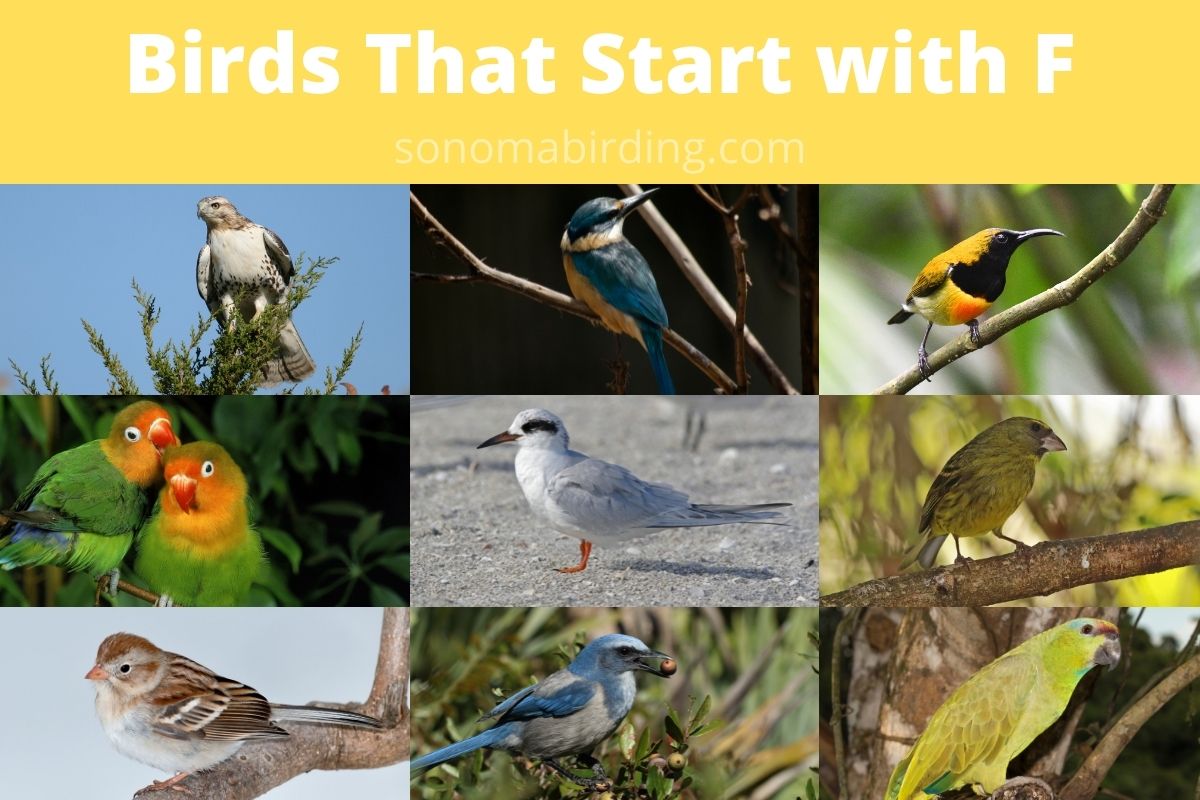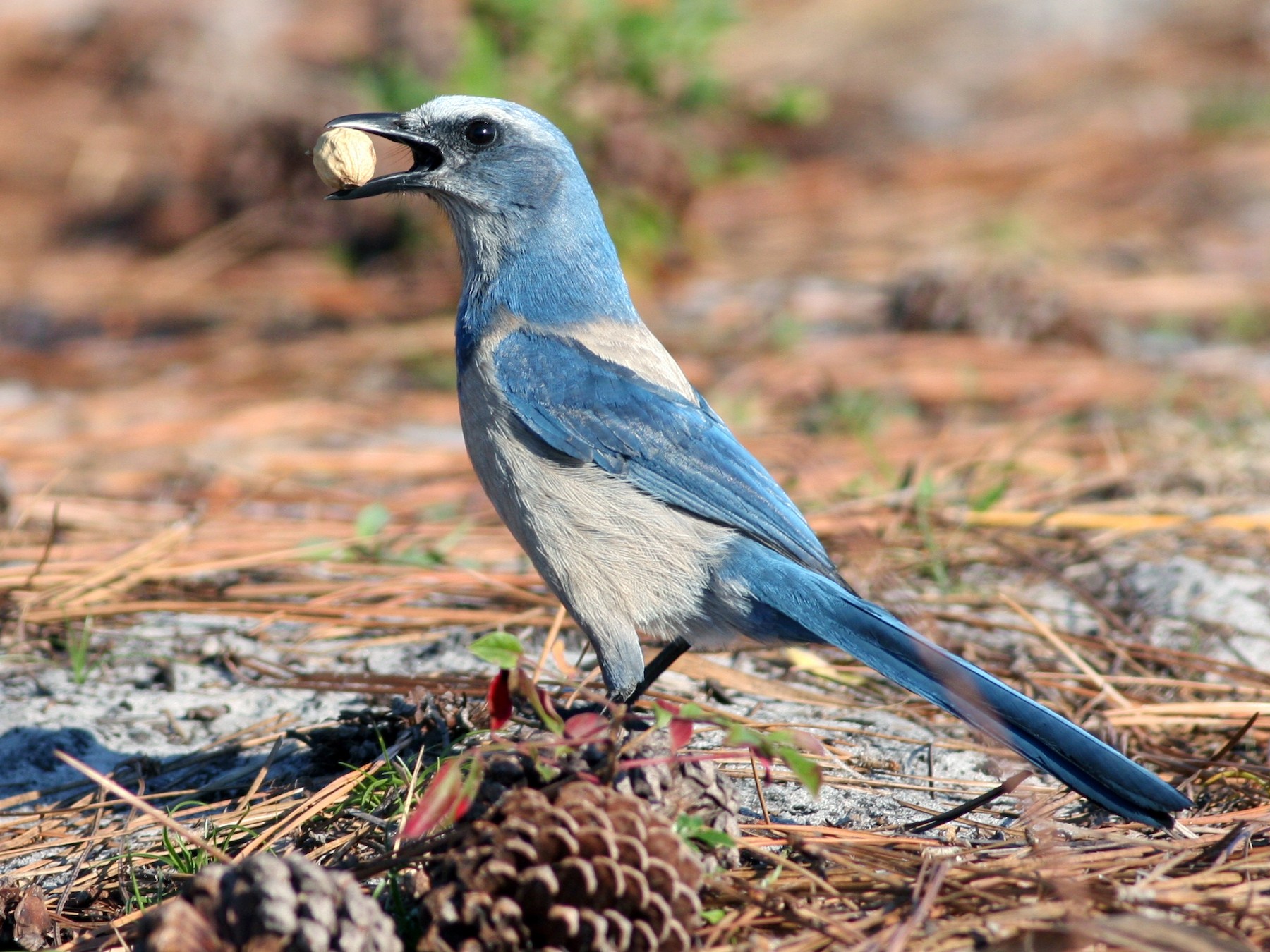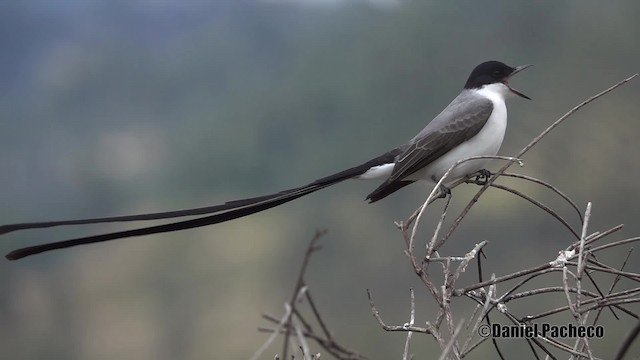Have you ever wondered how many birds start with the F? I have, and here’s a list of birds that start with the letter F. This list should give you lots of information about all kinds of birds! The goal is to make this post comprehensive enough for even the most die-hard bird aficionados out there, but at the same time entertaining enough for everyone to learn something new. Enjoy!
Ferruginous Hawk (Buteo regalis)

Colloquially referred to as the “Ferruginous Rough-leg,” the Ferruginous Hawks are large, broad-winged hawk species. These birds have been named after their rufous-colored body.
They’re the largest hawk species in North America and are often confused for an eagle due to their gigantic size.
Ferruginous Hawks have two color morphs, with the darker morph having a dark body and the lighter morph being rufous-brown.
They have a white tail and feathered legs, with both sexes possessing identical plumage. These birds display dimorphism in size, with the females being larger than their male counterparts.
Fish Crow (Corvus ossifragus)

As their name suggests, the Fish Crows are a piscivore corvid species found in the eastern and southeastern parts of the United States.
Although these corvids are closely related to the Tamaulipas and Sinaloa Crows, they resemble the American Crows in appearance. These birds are so similar superficially that it gets difficult to distinguish between them within their overlapping range.
However, the Fish Crows are smaller in size than them and have a glossier plumage. Both adult sexes have similar plumage and are sexually monomorphic. These birds have a distinctive, nasal call that sounds like “ark-ark-ark.”
Ferruginous Pygmy-owl (Glaucidium brasilianum)
The Ferruginous Pygmy-owls are a small owl species widely distributed throughout Central and South America. Within the United States, you can spot these owls in Texas and Arizona.
These typical owls are crepuscular in nature and often hunt during the daytime. Like the other pygmy owl species, they also have a small, stocky body with disproportionately large feet.
The diet of these birds mainly consists of smaller birds and mammals, lizards, and insects.
Fischer’s Lovebird (Agapornis fischeri)
Named after the German explorer Gustav Adolf Fischer, the Fischer’s Lovebirds are a tiny lovebird species belonging to the parrot family. These birds are endemic to the eastern parts of Africa and are common within northern Tanzania.
Both sexes of adult Fischer’s Lovebirds are sexually monomorphic. They have a yellow face with orangish touch around their bill. Their bill is bright red in color, with a prominent white eye-ring.
The underparts and upper parts of their body are bright green, with several blue or purple feathers on their tail.
Flammulated Owl (Psiloscops flammeolus)
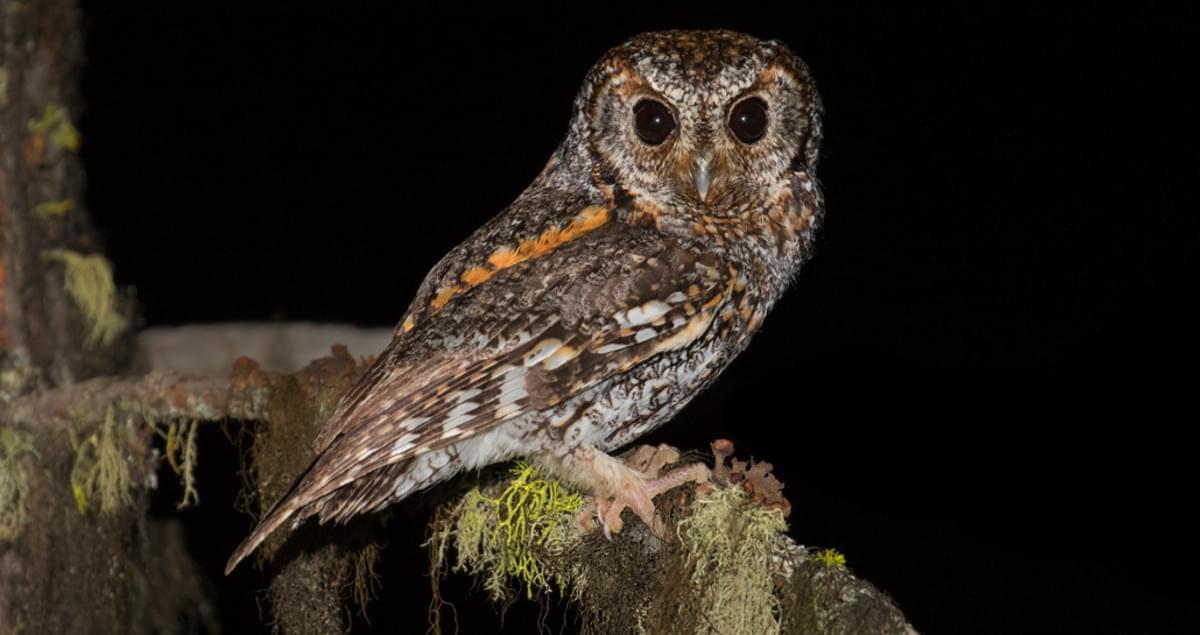
Named after their flame-like face markings, the Flammulated Owls are a migratory owl species breeding in the western United States and British Columbia. During winters, they migrate to Central and South America.
Flammulated Owls have a small body with relatively larger wings. Both adult sexes are similar in appearance; only the females are heavier than their male counterparts.
These owls closely resemble the Western Screech-owls but lack their ear tufts and are much more lightweight.
Flightless Cormorant (Nannopterum harrisi)

Also referred to as the “Galapagos Cormorant,” the Flightless Cormorants are a large aquatic bird species endemic to the Galapagos Islands. These birds are the only cormorant species that have lost their ability to fly, making them unique in the aquatic bird family.
Flightless Cormorants are a vulnerable species with an overall dark body. Their upper body is black, with dark brown undersides and a long, hooked bill. These birds have sturdy legs with webbed feet.
Fiji Goshawk (Accipiter rufitorques)

Endemic to the island country of Fiji, the Fiji Goshawks are medium-sized hawk species that inhabit the wooded areas on Fiji. These birds are sexually monochromatic and have a grey head, back, wings, and tail, with a dull pink underside. Both their legs and tail are quite long.
In terms of size, these raptors display dimorphism, with the females being larger in size. They have golden brown eye rings with a short, dark-tipped bill.
The diet of the Fiji Goshawks primarily consists of birds, particularly pigeons, rodents, and insects. At times, you will also find them going after chickens.
Festive Amazon (Amazona festiva)
Popular as pets due to their inquisitive nature, the Festive Amazons are a parrot species frequenting in the tropical rainforests. They’re one of the hardy parrot species that can even survive up to the age of 60 under the proper care and nourishment.
Festive Amazons have bright green plumage with faint black edges on their flight feathers. Their frontal face shield is red in color, with a touch of blue behind each eye.
They also have a thin, red eye ring that might not be visible from a distance. Some individuals even possess a pale-yellow patch on their cheek.
Forster’s Tern (Sterna forsteri)
Named in honor of the German naturalist Johann Reinhold Forster, the Forster’s Terns are a migratory tern species of the Americas. These seabirds breed across North America and travel south to Central and South America during the winter months.
Forster’s Terns are colonial birds that gather in large flocks on the marshes to breed. In appearance, they closely resemble the Common Terns and have a white head and underbody with grey wings and tails.
The adults of both sexes harbor a similar plumage, although they do undergo some minor seasonal changes.
Fasciated Tiger Heron (Tigrisoma fasciatum)
The Fasciated Tiger Herons are one of three members in the tiger heron genus that inhabit the riversides in Central and South America.
Within their genus, these tiger herons are the smallest in size. The adults possess a dark crown and upper parts with buff stripes scattered all over them. Their under-face and underbody are greyish, with a touch of cinnamon.
Field Sparrow (Spizella pusilla)
The Field Sparrows are a resident sparrow species that are widespread in the eastern parts of Canada and the United States. These birds are primarily ground-foragers and mainly eat insects and seeds.
Although Field Sparrows are sexually monomorphic, they do occur in two color morphs: a grey and a rufous-brown one. They have dark eyes and a short, thick bill colored in pink.
There are dark streaks on their face and wings, while their underparts are comparatively paler and unmarked.
Florida Scrub-jay (Aphelocoma coerulescens)
The Florida Scrub-jays are a vulnerable scrub jay species endemic to Florida, just as their name suggests. The population of these birds has been on a steady decline in the last couple of decades, mainly due to the deforestation of large oak trees.
Florida Scrub-jays are a popular species among the birders. The adults are sexually monomorphic and have a blue head, back, wings, and tail, with greyish underparts. Their eyes, bill, and legs are all dark in color.
Fulvous Owl (Strix fulvescens)
Also colloquially known as the “Guatemala Barred Owl,” the Fulvous Owls are a typical owl species that commonly inhabit the highland habitats throughout Central America.
These owls have a rounded head and medium-sized body with a pale ochre facial disk and dark eyes. They lack ear tufts but have white eyebrows.
Both sexes have a similar rich brown body with paler underparts and display dimorphism in size, with the females being heavier.
Fea’s Petrel (Pterodroma feae)
Also referred to as “Gon-gon” and “Cape Verde Petrel,” the Fea’s Petrels are a small, nocturnal petrel species breeding on the islands of eastern Atlantic Oceans. Because of their predation by the gulls, the IUCN has placed these seabirds in the Near Threatened List.
Fea’s Petrels have been named after an Italian zoologist, Leonardo Fea. In appearance, they closely resemble the smaller Zino’s Petrels. They have a smooth plumage, due to which they’re also popular as “Soft-plumaged Petrel.”
The adults have a dark head and upper parts, with a white belly and a dark, thick bill. Both sexes appear similar, displaying minimal dimorphism.
Forest Buzzard (Buteo trizonatus)

The Forest Buzzards are a resident African raptor species that are commonly believed to be a subspecies of the Mountain Buzzards. You can easily find these birds of prey in the wooded habitats of eastern South Africa.
Forest Buzzards bear a striking resemblance with the European Steppe Buzzards. Their head and upper body are dark brown in color, with rufous wing edges. In contrast, their under-chin and underparts are whitish in color, marked with brown spots.
The adult Forest Buzzards are sexually monochromatic, with the females being larger in size than their male counterparts.
Fan-tailed Raven (Corvus rhipidurus)
Named after their characteristic fan-like tail, the Fan-tailed Ravens are large passerine birds within the corvid family. These birds are endemic to the Arabian Peninsula and the eastern parts of Africa.
Fan-tailed Ravens primarily inhabit open dry areas and deserts and have a unique, vulture-like glide. Like the other raven species, they, too, possess an entirely black body, including their eyes, bill, legs, and feet.
Their plumage reflects a purplish gloss when it catches the sunlight. After some wear, the plumage is likely to turn copper-brown. Fan-tailed Ravens are also recognizable for their frog-like croaking call.
Forest Kingfisher (Todiramphus macleayii)
Forest Kingfishers are a tree kingfisher species common across eastern and northern Australia, Indonesia, and New Guinea. These birds are also referred to as “Macleay’s Kingfishers” in honor of Alexander Macleay, a Scottish entomologist.
The face and underparts of these kingfishers are white, with a dark blue patch on their head, extending to their eyes. Their wings are azure-blue with darker edges and a dark tail.
Both sexes display a similar plumage, with the females being slightly more lightweight than their male counterparts.
Franklin’s Gull (Leucophaeus pipixcan)
The Franklin’s Gulls are a migratory seagull species that breed in the northern regions of the United States and central provinces of Canada. These seabirds have been named after Sir John Franklin, an Arctic explorer.
Franklin’s Gulls are colonial breeders that gather near the prairie lakes during the spring and summer months. The adults are sexually monomorphic but undergo slight physical changes with the changing season.
They have a mainly white body with a dark bluish head with grey touches to their wings. Both their bill and legs are red-colored. During winters, much of their dark hood fades away, appearing significantly lighter.
Fox Kestrel (Falco alopex)
The Fox Kestrels are an African falcon species commonly inhabiting the open country, arid landscapes. These raptors have a long but slender body with relatively narrow wings and a long tail.
Their plumage is rufous-colored and bears heavy black streaks with dark, unbarred flight feathers. In plumage, both sexes are identical, although the females are roughly 3% larger than their male counterparts.
Forest Robin (Stiphrornis erythrothorax)
The Forest Robins are tiny African thrush species that commonly dwell in the wooded habitats across the central and western parts of Africa. These birds are monotypic members of their genus.
Forest Robins have a dark face, eyes, bill, and upper parts, with their underparts covered in a flame-like orange shade. Some subspecies also have pale yellow underparts. There’s little info about the sexual dimorphism seen in adults.
Falcated Teal (Mareca falcata)
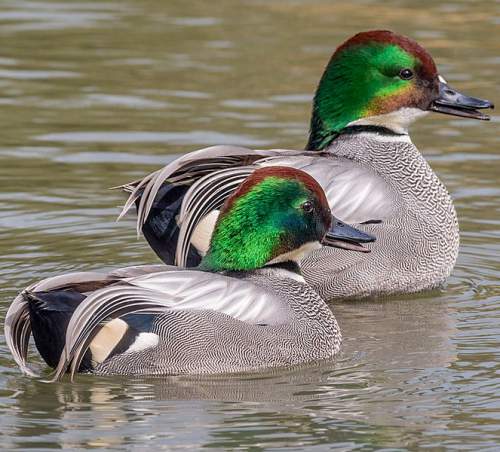
Closely related to the Gadwalls, the Falcated Teals or Ducks are a moderately-sized dabbling duck species common across breeding in the eastern parts of Asia. They’re migratory in nature and travel to the northern region of Southeast Asia in the winter months.
Falcated Teals are similar to the Gadwalls in size, with no differences between the sexes. However, they’re significantly dimorphic in plumage. The males have a dark head with a green gloss on it, a white neck and throat, with a darkly streaked underbody.
On the other hand, their female counterparts are mostly rufous brown in color.
Fork-tailed Flycatcher (Tyrannus savana)
Belonging to the tyrant flycatcher family, the Fork-tailed Flycatchers are an American passerine bird species. These tiny birds heavily populate mangroves, riparian forests, and open residential grounds.
Fork-tailed Flycatchers have a slender body with a relatively long tail. They have a black cap, wings, and tail, with white underparts. Both sexes are similar; only the males have a longer tail than their female counterparts and often sport a yellow crown stripe.
Forest Owlet (Athene blewitti)
The Forest Owlets are an endangered typical owl species native to the Indian subcontinent. These birds of prey are strictly forest-dwellers, rarely seen among human settlements.
Forest Owlets have a small, stocky body with a relatively large face. Their wings and tails are heavily banded. They have greyish-brown upper parts with paler underparts. Both sexes have similar plumage.
Flame Robin (Petroica phoenicea)

Named after their flame-colored underparts, the Flame Robins are tiny, Australasian robin species that are colloquially known as the “Robin Redbreasts.” They’re a resident species that primarily inhabit the upland areas of Australia and Tasmania.
Flame Robins are the largest members of all red robins and are sexually dimorphic. The males possess the characteristic flame underparts, with their heads, wings, and back being dark grey in color. They also have a white patch above their bill, white bars on their wings, and a white rump.
On the other hand, their female counterparts have a much duller plumage. Their head and upper parts are covered in a brownish shade, with buff-colored underparts.
Forest Canary (Crithagra scoops)

Endemic to South Africa and Swaziland, the Forest Canaries are tiny finch species that mostly dwell in the thick tropical montane and lowland forests within their range. These birds are colored rather attractively, and the adults display sexual dimorphism.
The male Forest Canaries are mainly yellow in color, with touches of black on their face and dark streaks on their wings and tail. On the other hand, their female counterparts are a paler shade of yellow, with a grey face and heavier streaking.
Fire-bellied Woodpecker (Chloropicus pyrrhogaster)

The Fire-bellied Woodpeckers are an African woodpecker species widely distributed in Ghana, Ivory Coast, Togo, Nigeria, and Cameroon.
These birds have a brown head, wings, and tail, with olive or orangish undersides. Both sexes display a significant dimorphism and are easily distinguishable.
The males have a red crown and nape, which is black in their female counterparts. Moreover, they also possess a shorter tail and longer bill than the females.
Fire-bellied Woodpeckers are primarily insectivores, particularly enjoying the beetle larvae a great deal.
Floreana Mockingbird (Mimus trifasciatus)

Endemic to the Floreana Island of the Galapagos, the Floreana Mockingbirds are an endangered species of the mimid family.
These birds are also referred to as the “Charles Island Mockingbird” because it’s believed that they inspired Darwin in his origin of species theory.
The adult Floreana Mockingbirds have a similar plumage and display dimorphism in mass, with the males being heavier than their female counterparts. Both sexes have a dark brown head and upper body, with whitish underparts and a dark chest patch.
These mockingbirds are primarily ground foragers that actively seek insects to feed on but will also eat the eggs of other birds (particularly seabirds), cactus fruits, and even carrion.
Flaming Sunbird (Aethopyga flagrans)
The Flaming Sunbirds are among the smaller members of the Nectariniidae family, which includes other sunbirds and spiderhunters.
These birds were placed in the Threatened Species List by the IUCN until very recently and have been moved to the Least Concern List in 2013. They’re endemic to the islands of the Philippines.
Just as their name suggests, these birds have a yellow, flame-like upper belly, while their underparts are olive-colored. Their head and throat are covered in a dark purple shade.
Conclusion: Birds That Start With F
It’s been a lot of fun learning about these birds, hasn’t it? I’ve known some other birds that start with the letter F, but we just didn’t have enough capacity to cover them in this article. I do think we didn’t leave out some pretty spectacular and fascinating birds, though.
I hope you enjoyed our example and learned something new and interesting from it. That’s what it’s all about!
Birds By Alphabet (A-Z List)
Birds that Start with A
Birds that Start with B
Birds that Start with C
Birds that Start with D
Birds that Start with E
Birds that Start with F
Birds that Start with G
Birds that Start with H
Birds that Start with I
Birds that Start with J
Birds that Start with K
Birds that Start with L
Birds that Start with M
Birds that Start with N
Birds that Start with O
Birds that Start with P
Birds that Start with Q
Birds that Start with R
Birds that Start with S
Birds that Start with T
Birds that Start with U
Birds that Start with V
Birds that Start with W
Birds that Start with X
Birds that Start with Y
Birds that Start with Z

